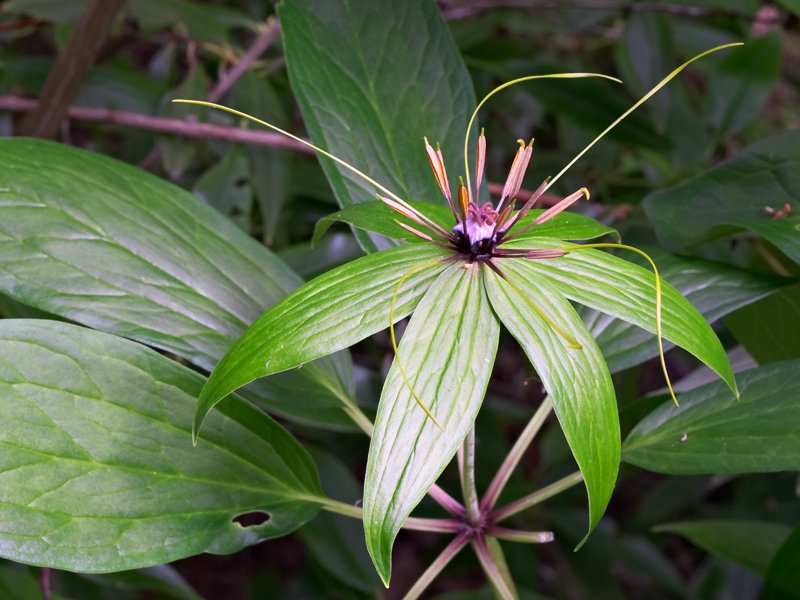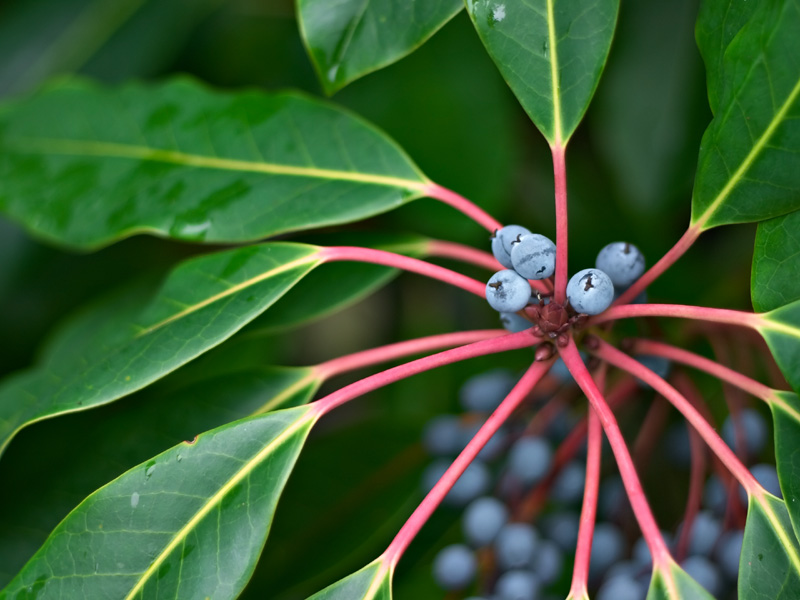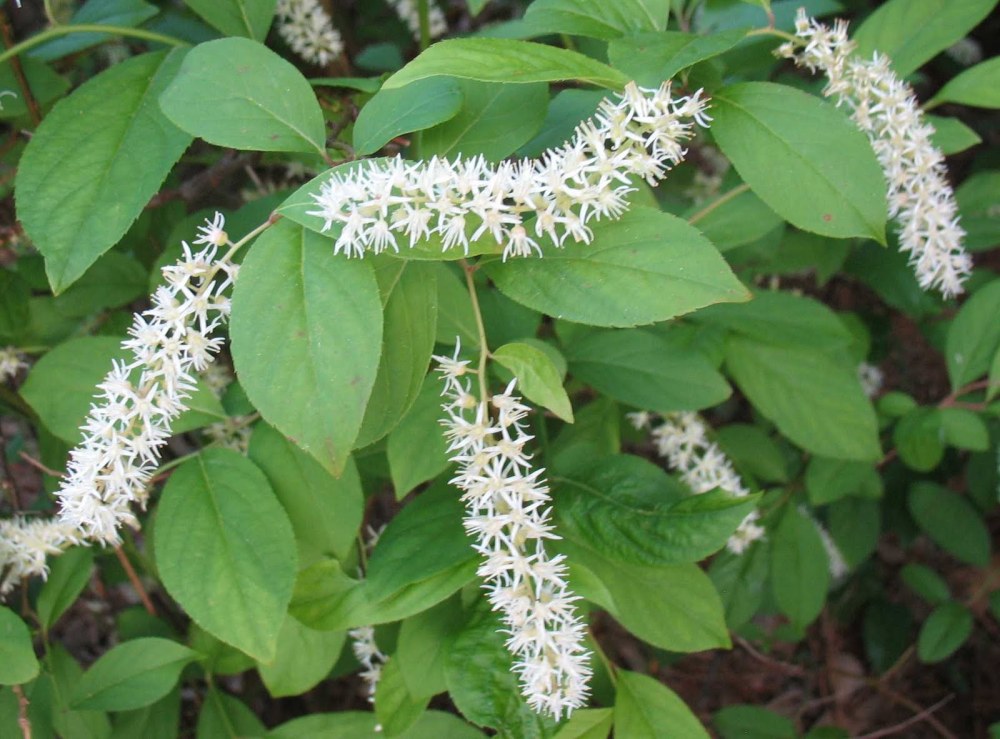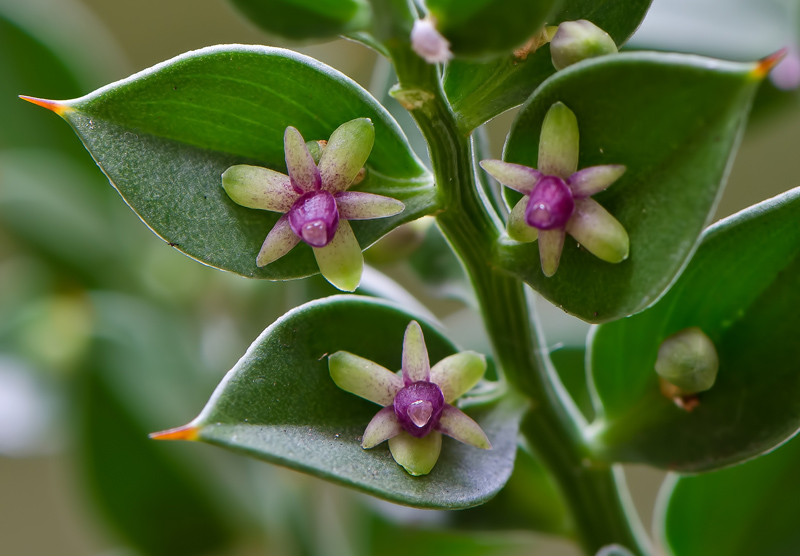I admit without apology, but also with no pride, that I am not a book reader. For better or worse, I haven’t the attention span to relax for a few hours with a good book, though I read the newspaper religiously, and I will wade through the densest academic writings, so long as they are short (paragraphs, not pages).
In any case, over the past few weeks I’ve slowly worked my way through books on botany and plant taxonomy, and even this didactic reading has been enough to stir the creative juices. If you’ve visited these pages previously you might recall that this twenty-some year old garden covers the majority of an acre and a quarter property, and dozens of Japanese maples, redbuds, dogwoods, and a variety of other trees and shrubs are tightly planted so that the maximum number are crammed into this area.
Regardless of the lack of open space, I’ve been inspired to begin a list of plants (Paris polyphylla, above) that I’ll look out for in the spring. A few of these might not be available in the garden center, so I’ll search through a few dependable mail order sources, though my success with starting small plants is not so great. I’ve made plans more than a few times to prepare a common area for these new arrivals so that they can be monitored and not suffer from neglect when they are scattered through the garden. But, as you can guess, no such area has been constructed, so I order small plants hesitantly.
As the garden has neared full capacity, my choices for new plant additions are made more carefully, though I remain too willing to shoehorn a highly desired plant into an area that is too small, and figure out later what to do when this becomes a problem. For this failing, again I do not apologize, for most everything seems to work out satisfactorily in the end, and only a few plants are lost in the process.
When I discuss the garden with other folks I’ve too often been guilty of remarking (in jest) that I’ve planted at least one of everything (Helwingia chinensis, above), and though this can seem so, it is far from the truth. In fact, I cannot claim to have planted even one of everything that I’ve lusted after, for this garden would need to be many times larger than the one I have. I’m envious of large public gardens, though I haven’t a clue how I could manage to care for anything larger than this property.
With limited area for planting, my choices are mostly dictated by soil and sunlight conditions in the scattered open spaces. In the lower garden the soil is damp, and seemingly getting wetter by the year. In the past year several sturdy shrubs have showed signs of decline due to the months long dampness, so any additions here must be suited to saturated soil and part to moderate shade. In the wettest areas I’ve given in to allow vigorous mints to roam as they please along the ground, but with an eye to keep them from clambering into and damaging shrubs.
A native forest of swamp maples and tulip poplars with scattered dogwoods and oaks runs along the lengthy southern border of the garden, and here moderate to heavy shade and root-infested, dry soil is the concern (though a few shaded areas have deeper, and even moist conditions). With this less than ideal situation, camellias, hydrangeas, azaleas, and mahonias grow more slowly, and so the gaps between plants are more sizable. A collection of various hellbores, epimediums, euphorbias, hostas, and other drought tolerant perennials covers much of the open ground between shrubs. Here, there are spaces to add native shrubs that have disappeared from other areas of the garden over the years such as Virginia sweetspire (Itea virginica, below), and oddities that have grabbed my attention (Daphniphyllum macropodum above, Helwingia, and Ruscus).
I’m determined that more hydrangeas can be jammed into the sunnier parts of the rear garden, though I’ve learned that there is a point where enough moisture is too much, and I must caution against planting in areas where the ground remains saturated for weeks. It’s possible that already there are a satisfactory number of spring flowering shrubs (Ruscus aculeatus, below) in the garden, but the limit for summer and autumn (also winter) flowers is far off. So, with ample leisure time and a bit of reading, I’ll cogitate on preparing, then revising a list of plants that will end up being planted in the spring.
Beautiful photos of some amazing plant choices. I’d be interested to hear which botany and taxonomy books you’ve been reading.
Reading two books by plant explorer Daniel Hinkley provoked some interest in plant taxonomy, and I’ve long needed a primer to fill the gaps in my meager knowledge of botany. Practical Botany for Gardeners by Geoff Hodge plugs some of these holes. Besides Michael Dirr’s reference Manual of Woody Landscape Plants, I’ve begun to follow Cultivar.org and particularly the free downloads from Ornamentals Quarterly.
Some really useful resources there – thank you for sharing.